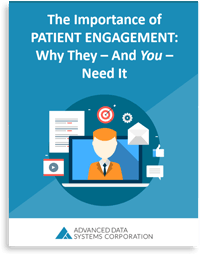Healthcare Blog
The latest in all things RCM, Electronic Health Records, Radiology Information Systems, Practice Management, Medical Billing, Value-Based Care, & Healthcare IT.

Industry News | Healthcare Advice
By:
Advanced Data Systems Corporation
September 26th, 2014
The following is an excerpt from an article by Carl Natale. This article originally appeared on Government Health IT. Next week marks another ICD-10 milestone: One year left to go. For those of you just deciding to take it seriously now, start with education. Educate Thyself You can start with some free resources to help you understand what the ICD-10 transition means for your medical practice.

Medical Billing / RCM | Practice Management
By:
Stephen O'Connor
September 24th, 2014
Medical billing software provides increased convenience for providers, less tracking of paperwork, and a more streamlined office. Physicians no longer spend valuable administrative time looking for records and retrieving past patients medical records from off-site storage facilities. Medical billing software can save money by avoiding claim denials and avoid the possibility of submitting incorrectly formatted claims.

The Importance of Patient Engagement: Why They - And You - Need It
Learn why patient engagement is a necessity and how you can master it within your practice.

By:
Stephen O'Connor
September 19th, 2014
Electronic Health Records, known as EHR, are real-time, digitized versions of traditional paper-based medical files. Digital medical records are cloud-based systems, meaning that the information entered into the electronic medical records software is stored in secure, remote servers to ensure patient privacy and system reliability.

Industry News | Healthcare Advice
By:
Advanced Data Systems Corporation
September 15th, 2014
The following is an excerpt from an article by Craig Greenberg, Practice Director for Strategic Services at Consultancy Beacon Partners. This article originally appeared on Health Data Management. "The fall is fast approaching and with that brings the reminder that the new ICD-10 compliance deadline of October 1, 2015 is a little over a year away. Before the delay, healthcare organizations were working diligently on their transition plans and many were making progress on addressing key implementation challenges.

Electronic Health Records | Industry News
By:
Advanced Data Systems Corporation
September 15th, 2014
The following is an excerpt from an article by Stephanie Ocano of Healthcare Global. This article was originally written by Adam Groff and appeared on healthcareglobal.com. The paperless revolution is taking the world by storm, so it's no surprise hospitals across the United States are jumping on the paper-free bandwagon. From digitized patient files to paperwork and documents sent by email, the medical community is embracing a paperless lifestyle.

By:
Stephen O'Connor
September 12th, 2014
Whether you like it or not, your medical organization is going to have to make the switch from the International Classification of Diseases version 9 to ICD-10. Some healthcare providers may have grown complacent because they have seen the U.S. government declaring that the deadline for the switch would be a few years ago, only to see an extension until 2014. The latest deadline is October 1, 2015, and we should work under the assumption that this will be the last extension from the government. As a prudent leader in your healthcare group, you’re not likely going to want to delay any further in getting your team ready for the impending transition. With that in mind, here are some tips to help you move beyond ICD-9.

By:
Stephen O'Connor
September 10th, 2014
As you already must be aware, a big change is coming to the healthcare industry, now that the U.S. government is requiring us to switch from ICD-9 to ICD-10. Version 10 of the International Classification of Diseases has already been adopted by many countries around the world, but our government has granted a few extensions so that providers can spend more time preparing for the switch.

By:
Stephen O'Connor
September 8th, 2014
Busy owners and managers of medical practices may not always be able to budget much time to keep up with the latest healthcare industry news and regulatory updates. You have likely been briefed, however, on the U.S. government’s mandate that providers must switch from version 9 of the International Classification of Diseases code to ICD-10. Developed and maintained by the World Health Organization, the ICD codes provide international standards for describing ailments and diagnoses, enabling the industry and government entities to communicate more easily. Since the transition to ICD-10 has been delayed until October 1, 2015 in the U.S., now is a good time to consider that what you don’t know about ICD-10 may hurt you.

By:
Stephen O'Connor
September 5th, 2014
Obviously, no one is born a computer expert or can be considered proficient at using software without becoming familiar with all the settings, features, navigation elements, menu options, and so on. Your staff had to become familiar with EHR software and how to use the International Classification of Disease code version 9 in order to let your practice operate in accordance with industry standards and government regulations.

By:
Stephen O'Connor
September 3rd, 2014
No matter how many great educational institutions we have turning out top-notch medical professionals, and no matter how many great managers are available to run medical organizations in the most efficient and cost-beneficial manner, the level of quality will vary from practice to practice. Be honest. How would you rate your own practice? For that matter, can you remember the last time you did a complete evaluation of how you run the organization? Is it possible that some things are starting to slip through the cracks, or that you have lost some talented employees and haven’t found replacement workers who can fill their shoes? By emulating the actions of great medical practices, you can move forward with better confidence.